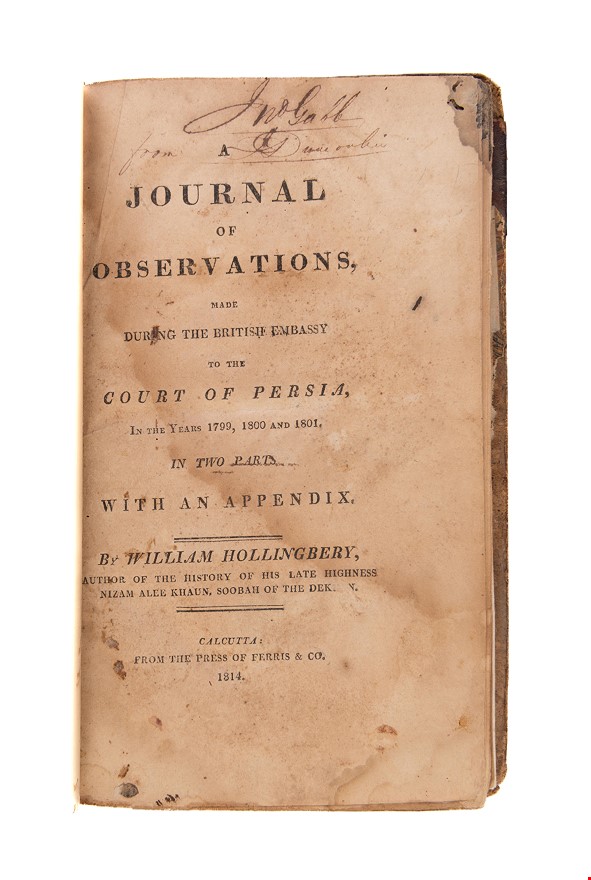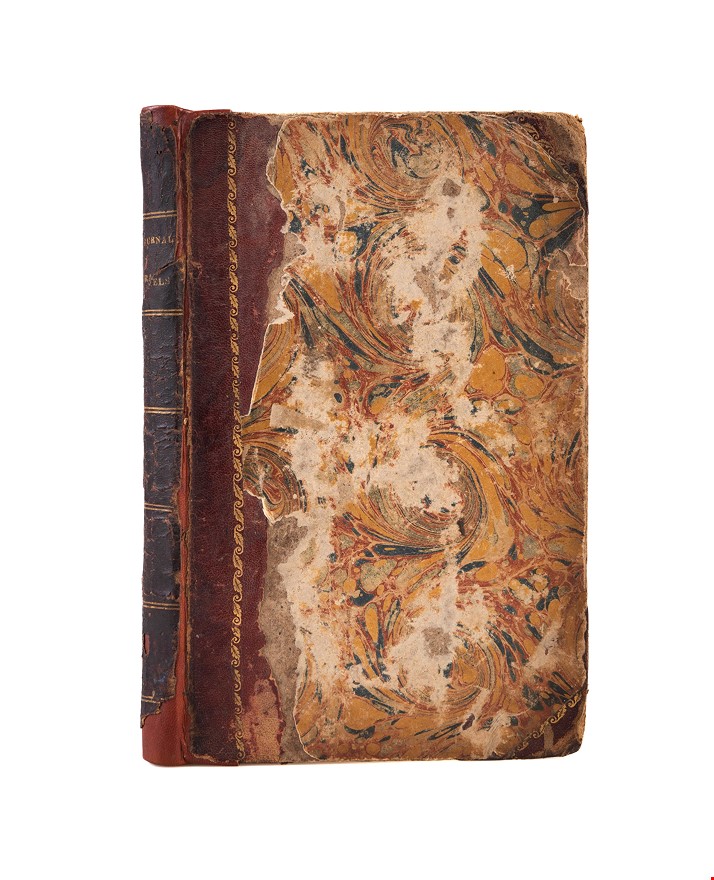A Journal of Observations, made During the British Embassy to the Court of Persia, in the years 1799, 1800, and 1801.
HOLLINGBERY William (1814.)
£15000.00 [First Edition]
Please contact us in advance if you would like to view this book at our Curzon Street shop.
RARE CALCUTTA-PRINTED ACCOUNT OF QAJAR IRAN
First edition. 8vo. Contemporary half calf and marbled boards, gilt lettering to spine; recased with new endpapers, rebacked with old spine laid down on new leather, corners worn, marbled paper rubbed and tatty at extremities. A little (defunct) marginal worming, interior pages water-stained, with some darker staining to the top right corner of the first fifty or so pages. Ink presentation inscription to ‘J.W. Gabb from J. Dumoulin’ at top of title-page. A scruffy but complete and firmly intact copy of a very rare book. Housed in a modern cloth solander box. [2], iii, [1], iv, 135, [1], xxv, [1], vi [subscribers]pp. Calcutta, From the Press of Ferris & Co.,
A rare and important travel account, written by a member of Sir John Malcolm’s famous embassy to Persia in 1799-1801. It offers a valuable picture of Iran during the early period of Qajar rule, which would last for more than a century.This copy belonged to a subscriber, James Dumoulin, who was an active figure in the literary scene of early nineteenth-century Calcutta and produced the second complete English translation of Sa’di’s Gulistan.
William Hollingbery (c.1767-1809) wrote one other work, a history of the Deccan and its rulers, before composing A Journal of Observations… upon his return from Persia. Publication was first delayed as the government proofed the manuscript, and then by Hollingbery’s untimely death in 1809. It eventually appeared posthumously, with added footnotes (mostly containing biographical information) by an anonymous editor.
As Hollingbery could not publish any sensitive political information there is no mention of the motivations behind the mission, or the content of the treaties made with Fath-Ali Shah Qajar (1769-1834) — a commercial treaty guaranteeing the mutual protection of British and Persian merchants, and a political treaty obliging the two powers to jointly repel an Afghan invasion of India and/or a French invasion of Persia. Instead, his journal focuses on the topography, antiquities, contemporary culture and populations the embassy encountered on its journey.
It begins with the voyage from Bombay to Bushire, which included visits to Muscat, “the emporium for the trade of India with the Persian Gulph and Red Sea” (p.6), Hormuz Island and Kharg Island. Thence the overland route westward through Dalaki, Khesht and Kazerun, to Shiraz where the embassy was received by Hossein Ali Mirza, the Governor of Fars. There, as at other major cities, the embassy was stalled by official exchanges, displays and other forms of time-absorbing pageantry, which allowed Hollingbery to gain more than a casual impression of the city's infrastructure and daily life. Interesting notes examine produce, with a nice passage on wine (see, p.40), and notable buildings, such as the tombs of Hafiz and Sa’di.
A determined march through Fars took them within reach of Isfahan, where they met with a cavalcade of true grandeur: “about two thousand cavalry, and three or four thousand foot, which with the citizens, whom curiosity had brought out, amounted at the least to thirty thousand souls.” (p.60). Once within the city, Hollingbery explored the Chaharbagh and studied the paintings embellishing the western chamber of Chehel Sotoun. The fading Safavid finery contrasted with the less elegant appearance of the newly chosen capital, Tehran, which the embassy reached in November 1800. Alongside valuable notes on its defences and fluctuating population — estimated at no more than 12,000 in Summer and no less than 70,000 in Winter — Hollingbery recounts Malcolm’s first and second audience with the Shah. Upon seeing the monarch for the first time, he was struck by his dress and “handsome person”, paying compliment to the jewels adorning his outfit (“not less than a million sterling”) and his beard “which is supposed to be the largest in his dominions” (p.81).
The final part of the narrative covers the return journey to India, by way of Hamadan, Kermanshah, Khanaqin, Baghdad, and a cruise down the Tigris to the Persian Gulf. Despite being a little brisker in his descriptions, Hollingbery’s eye still paused over archaeological sites such as the Behistun inscription, the Taq-e Bostan Sassanid carvings and the “strange superstructure” (p.125) of the Ctesiphon Arch (Taq Kasra). The main text is then followed by three appendices, the most valuable of which is Hollingbery’s short discourse on the ruins of Persepolis (p.vi-xxi), adding greatly to the short section in his journal.
Provenance: James Dumoulin, translator of the Gulistan (The Goolistan, Calcutta, Mirror Press, 1807). As well as being listed as a subscriber (p.ii) he is also mentioned in two footnotes, on page 37 and 44. The former, below the passage on Sa’di’s tomb, pays compliment to his work: “The oriental literary world is much indebted to Mr. James Dumoulin for a faithful and most excellent translation of that celebrated work.”
Rare. Hollingbery’s Journal is among the rarest English-language works on Iran, more so than the Indian issues of Francklin’s Observations made on a tour from Bengal to Persia (Calcutta, 1788) and Waring’s A Tour to Sheeraz (Bombay, 1804), both of which are more widely held institutionally and have appeared at auction in recent years. It most likely had a short print run and lists only 142 subscribers. Libraryhub locates one copy in the UK, at the British Library. OCLC finds just two more, at the Royal Danish Library and the Bibliothèque Nationale de France.
Wilson, p.98. Diba and Ghani both list a reprint (Tehran, 1976) but not the original publication.
.
Stock Code: 244061





